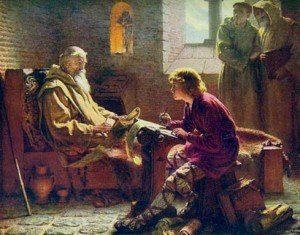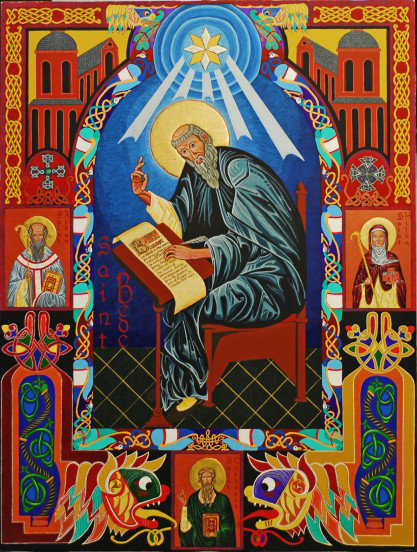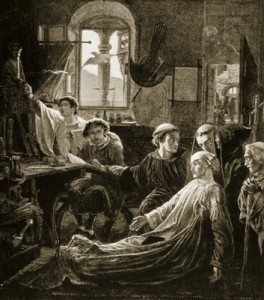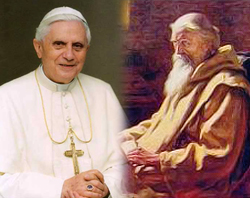
Summary of St Bede: A monk, historian of the early English Church, and master of the Scriptures and of the teachings of the Church Fathers. Known for his scholarly writings. Venerated as the “light of the Church” in the period called the Dark Ages and as a forerunner of the eighth and ninth century renaissance of the Western Church. Venerable Bede was the last of the early church fathers
 Bede was a monk, an historian and a scholar whose delight it was to impart to others something of his great knowledge, and and he did so with a humility and an ease that endeared him to his fellow monks.
Bede was a monk, an historian and a scholar whose delight it was to impart to others something of his great knowledge, and and he did so with a humility and an ease that endeared him to his fellow monks.
His best known work is The Ecclesiastical History of the English People. Fr John Murray PP tells his story.
Anno Domini
This ‘lesser-known’ saint is one whom we all ‘know’ inadvertently. Every time we sign a cheque or write a letter or glance at the calendar or check our mobile to see what day it is, we owe a debt to the Venerable Bede, an English monk who lived in the late 7th and early 8th centuries.
The practice of dividing time into BC (‘Before Christ’) and AD (‘Anno Domini’) (the year of the Lord) wasn’t actually invented by Bede. He, like the good scholar that he was, attributed this to Dionysius, a Roman abbot, who lived between 500 and 550. However the system lay relatively unused for two hundred years until Bede started to popularize it. Soon it spread to Europe and was taken up by the Holy Roman Emperor Charlemagne and later by the Popes.
Pupil and Benedict Biscop
Born in 672 in Jarrow, Northumberland, Bede was entrusted to the care of the abbot Benedict Biscop at the monastery of St. Peter in Wearmouth, near Sunderland in northeastern England. In 685 he moved to a new monastery in Jarrow and records suggest that he never moved from there until his death in 735, devoting himself to the study of the scriptures and to the writing of history with which he became more famous.
 His works show that he had at his command all the learning of the time. It was thought that the library at Jarrow had about 500 books, making it one of the most extensive in the whole of England. Bede’s mentor, Benedict, did his best to ensure that the library continued to be well stocked and added to it from his travels within the realm and to the continent of Europe. Indeed, even within Bede’s own lifetime he was regarded as one of the most intelligent men of his age, and the Council of Aachen in 835 referred to Bede as a contemporary doctor of the Church. Many of his commentaries on scripture were read extensively during the Middle Ages.
His works show that he had at his command all the learning of the time. It was thought that the library at Jarrow had about 500 books, making it one of the most extensive in the whole of England. Bede’s mentor, Benedict, did his best to ensure that the library continued to be well stocked and added to it from his travels within the realm and to the continent of Europe. Indeed, even within Bede’s own lifetime he was regarded as one of the most intelligent men of his age, and the Council of Aachen in 835 referred to Bede as a contemporary doctor of the Church. Many of his commentaries on scripture were read extensively during the Middle Ages.
He Lived for Eternity
Bede himself was a humble man and said that he was always ‘rejoicing to serve the Supreme Loving Kindness’. Yet while he made his name as a writer of history, he lived for eternity and wanted to use his writings to help men reach a happy eternity. ‘Many a learned man will be found at last among the lost and many a simple soul that has kept God’s commandments will shine among the apostles and doctors,‘ he wrote.
It was this standard which guided his historical writings. He did not actually begin writing until he was ordained a priest at the age of thirty and then only at the behest of Ceolfrid, an abbot, whom he revered. His effort then for the rest of his life was to bring to his fellow countrymen the teachings of the four great Western doctors: Jerome, Augustine, Ambrose and Gregory.
A modern historian has praised his contribution: ‘First among English scholars, first among English theologians, first among English historians, it is in the monk of Jarrow that English literature strikes its roots. In the six hundred scholars who gathered around him for instruction, he is the father of our national education.’ His access to the great library of Jarrow ensured that his research and study of the sources was as comprehensive as it could be at the time.
The Ecclesiastical History of the English People
Undoubtedly Bede’s major work was The Ecclesiastical History of the English People. It took him thirty years to complete and it is a mixture of history and hagiography (stories of the saints). In the first twenty-one chapters Bede treats of the period from the time of Caesar to the mission of Augustine to convert the English. Bede includes in his text of this later event an analysis of the correspondence between Pope St. Gregory and Augustine on this issue and other various moral questions. Such detail and scholarship was unknown at that time.
Bede too, was always scrupulous in recording the sources of his information – and in asking those who copied and edited his work to preserve these references (a practice which they did not always obey). Even today modern scholars regard his History as the authoritative account of Christianity in England from its inception to Bede’s own time.
A Man of One Place
Be de never moved any further than a fifty-mile radius from his monastery. He was much loved and revered by his own community. His devoted community kept vigil during his final illness. He himself continued to pray and work right up to the last moment.
de never moved any further than a fifty-mile radius from his monastery. He was much loved and revered by his own community. His devoted community kept vigil during his final illness. He himself continued to pray and work right up to the last moment.
Death and Feastday
Cuthbert, a student, relates how he completed dictation of a translation of the Gospel of St. John on the day of his death, the feast of the Ascension, 735, after which he supposedly fell to the floor and passed quietly away. He was buried in Jarrow initially but his remains now reside in Durham Cathedral having been moved there in 1370.
 The title ‘Venerable’ began to be applied within a couple of generations of his death as the influence of his writings spread.
The title ‘Venerable’ began to be applied within a couple of generations of his death as the influence of his writings spread.
However it wasn’t until 1899 that Pope Leo XIII canonised and gave him the title gave ‘Doctor of the Church’. Pope Benedict XIV said of him:
‘The Saint we are approaching today is called Bede made an effective contribution to building a Christian Europe in which the various peoples and cultures amalgamated with one another, thereby giving them a single physiognomy, inspired by the Christian faith.
Let us pray that today too there may be figures of Bede’s stature, to keep the whole continent united; let us pray that we may all be willing to rediscover our common roots, in order to be builders of a profoundly human and authentically Christian Europe.’
This article first appeared in The Messenger (May 2008), a publication of the Irish Jesuits.